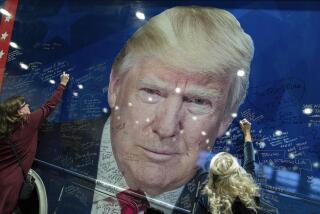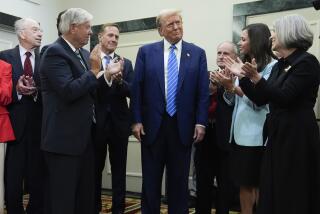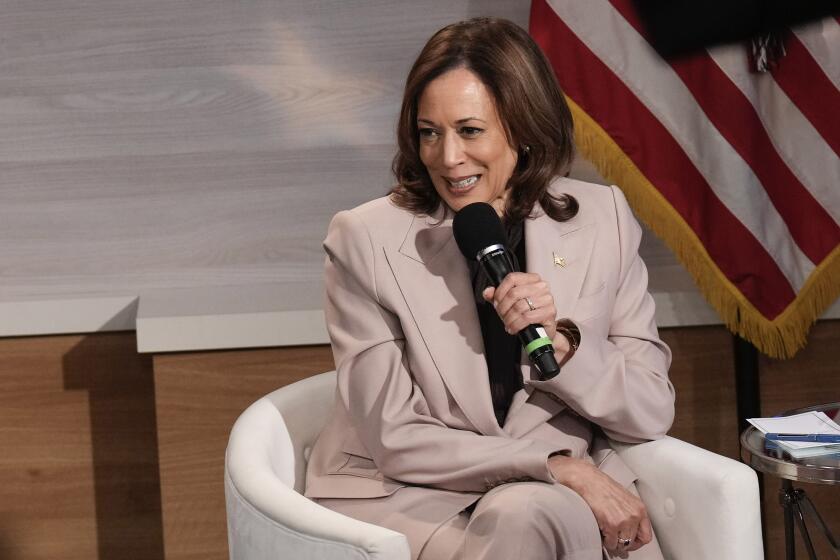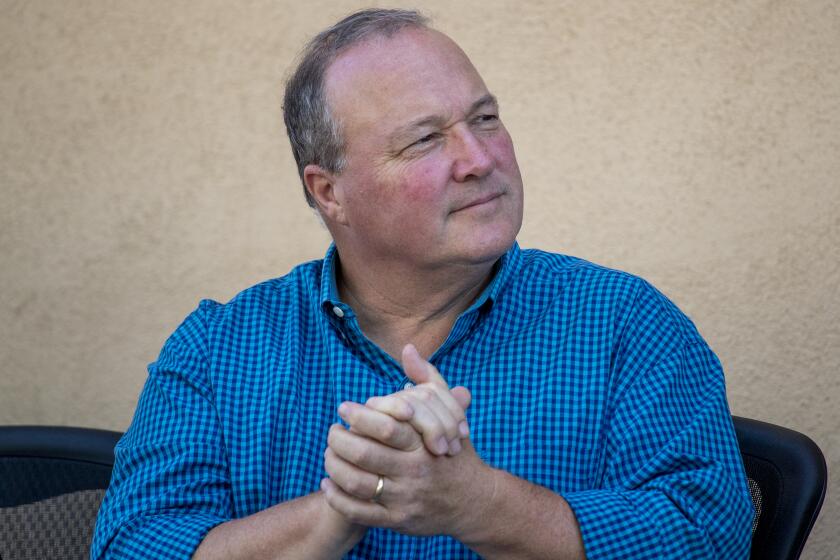A week of town halls puts the opposition to Trump on center stage
President Trump has dominated the news for months — a mixed blessing for him, albeit a spotlight he craves — but this week his opponents seized much of the attention.
With Congress in recess and members back home meeting constituents, town halls around the country became the focus of anti-Trump protests, as Mark Barabak wrote.
The question now is whether Democrats can build on that fervor, much of which was generated outside the traditional party structure.
Good afternoon, I’m David Lauter, Washington bureau chief. Welcome to the Friday edition of our Essential Politics newsletter, in which we look at the events of the week in Washington, D.C., and elsewhere in national politics and highlight some particularly insightful stories.
A MASS MOVEMENT, MAYBE
In 2009, town halls became rallying points for conservative opposition to President Obama’s proposed healthcare law, an early indicator of the fervor that fueled the tea party movement. The tea party has caused many headaches for Republican leaders ever since, but it also brought the party a congressional majority and blunted large parts of Obama’s agenda.
The counter-example came two years later: In Wisconsin, Scott Walker won election as governor in 2010, part of the GOP wave the tea party helped generate. He quickly pushed through a law that dramatically cut the union rights of public employees.
For weeks, demonstrations and rallies filled the state capitol in Madison. Union activists signed petitions to force a recall election. But all that energy failed to bring out enough new voters to change the electorate. Walker beat the recall, won reelection, and his brand of conservatism continues to dominate the state, which narrowly went for Trump in November.
Which path will the anti-Trump resistance follow? Will it energize voters, as the tea party did, or serve as an ultimately impotent expression of rage, like the Madison sit-ins? Can Democrats successfully convert demonstrators into voters and protest energy into electoral success?
Those are questions that will be much on the minds of Democratic Party leaders as they gather in Atlanta this weekend for the election of a new party chair.
An early clue could come from a special election to be held this spring in that city’s suburbs. At stake will be the House seat vacated by Tom Price, now Trump’s secretary of Health and Human Services.
Price won his district several times with little trouble, but Democrats never made much of an effort against him. In November, Hillary Clinton ran even with Trump in the district — one of several upscale, highly educated suburban areas in which she did significantly better than previous Democrats.
For the next couple of years, those suburban regions — including Orange County in California — will form a major battleground for American politics. A Democratic victory in Georgia’s 6th congressional district, or even a close call, would signal that the movement that stirred in this week’s town halls will be staying in that battle for the long haul.
A GOVERNMENT OF GENERALS
Trump, meanwhile, did something rare for him — he made a high-level appointment that followed the preferences of Washington’s establishment.
The choice Sunday of Lt. Gen. H.R. McMaster as the White House’s national security advisor signaled an abrupt about-face after the brief tenure of retired Gen. Michael Flynn, Mike Memoli and Laura King wrote.
Washington’s national security establishment regarded Flynn as an unstable ideologue ill-suited to the security advisor’s job, which over the years has often gone to high-profile grand strategists (Henry Kissinger under Richard Nixon, for example) or highly efficient managers of the national security apparatus (Brent Scowcroft under George H.W. Bush).
McMaster has been among the Army’s most admired officers, although one whose pointed criticism of senior officers slowed his career for a time. A military historian and a decorated battlefield commander, he won acclaim both in the Persian Gulf War, where tanks he commanded destroyed a much larger Iraqi force, and in the Iraq war, where he played a key role in developing the strategy that, at least for a time, quelled the insurgency.
His appointment drew praise from Trump critics, such as Sen. John McCain of Arizona, and leading Democrats.
One area where the change in security advisors could have a visible effect is in policy toward Russia. McMaster is likely to be much less enamored of leader Vladimir Putin than Flynn appeared to be. The White House, however, will still be battling allegations of improper contacts with Russia during the campaign.
Over the weekend, Reince Priebus denied any collusion with Russia on the part of Trump’s campaign.
Within the foreign policy establishment, the openly expressed hope is that McMaster, along with retired Generals James Mattis, the secretary of Defense, and John Kelly, the secretary of Homeland Security, can form a virtuous cabal to keep an impetuous president under control. Given that Trump picked each of them, it’s at least possible that he hopes so, as well.
IMMIGRATION BATTLES
Trump’s successful presidential campaign had several themes — jobs, trade, crime, resentment of urban elites — but none was more central than immigration. That same issue has dominated his first few weeks in office.
The administration’s executive order to temporarily ban travel from seven mostly Muslim countries remains blocked by a federal court, and the White House missed a self-set deadline to issue a revised order this week. Officials, saying the proposal is being carefully reviewed in hopes of meeting court objections, now promise a new order next week.
In the meantime, Kelly issued new policies this week for immigration officials to follow. The policy guidance vastly expands the number of immigrants in the country illegally who could be targets of immigration enforcement. It also opens the way for much faster deportation proceedings for many. Here are questions and answers by Brian Bennett and Amy Ficus about what the new rules mean.
The new policies have generated intense — and largely negative — attention in Mexico. Secretary of State Rex Tillerson went there this week, along with Kelly, in an effort to calm tensions. As Tracy Wilkinson and Patrick McDonnell wrote, that goal remains distant.
Part of the problem, Memoli wrote, is that the president and his top advisors use very different words to describe their policies. Trump, ever the salesman, likes to describe his plans as bold, unprecedented and disruptive. Kelly, Tillerson and other officials want to describe them as carefully thought through, incremental and mainstream. The results has been a series of mixed messages.
Whether immigration officials actually have stepped up enforcement remains unclear, although it seems certain they will eventually. But Trump’s policies already have raised the level of anxiety in many immigrant communities.
Meantime, as David Savage wrote, the Supreme Court is grappling with a case that raises an intriguing, but never answered, question: Does the Constitution protect foreigners who are at the border?
THE CONSERVATIVE CHAMPION
Only a year ago, Trump was, at best, a third choice for most conservative political activists. Texas Sen. Ted Cruz got the most support from the Republican right, while Trump did better among self-described moderates.
But under the guidance of his chief strategist, Steve Bannon, Trump formed a solid alliance with conservatives, shaping his administration around their preferences. And as Noah Bierman writes, this week’s gathering of right-wing activists at the annual CPAC conference has become a showcase for Trump’s dominance.
In part, conservatives love Trump for the enemies he has chosen, which prominently include the nation’s media. Campaigning against the press has been a repeated theme for the president, Memoli wrote.
On Friday, White House officials tried to push back on a CNN report. The network reported that Chief of Staff Reince Priebus had talked to a senior FBI official to try to get the bureau’s help in knocking down a New York Times story about the investigation of contacts between Trump associates and Russian intelligence officials. In the process, the White House officials largely confirmed most of the CNN report.
CPAC’s meeting was also the scene of a couple of skirmishes between mainstream conservatives and elements of the so-called alt-right, a movement that espouses white nationalism. White nationalist Richard Spencer was asked to leave, for example.
The presence of alt-right leaders among Trump’s supporters has led to accusations that the president has turned a blind eye to anti-Semitism and other forms of bigotry. On Tuesday, after weeks of prodding, Trump denounced anti-Semitism. His words came amid a wave of bomb threats — all hoaxes, authorities have said — directed at Jewish community centers, as well as the toppling of some 200 gravestones at an historic Jewish cemetery near St. Louis.
DID THE USC/L.A. TIMES POLL ‘GET IT RIGHT’?
In his CPAC speech, Trump praised the “Daybreak” tracking poll that USC and The Times published daily during the election. The poll was the only major survey that consistently showed Trump winning.
“A couple polls got it right. I must say Los Angeles Times did a great job, shocking because, you know, they did a great job,” Trump said.
But was the poll right? The answer isn’t so simple.
STATES’ RIGHTS?
Late Tuesday, after widespread reports of disagreement between Atty. Gen. Jeff Sessions and Education Secretary Betsy DeVos, the administration rescinded a letter that the Obama administration had sent to school districts in May on the rights of transgender students.
The Obama administration said the issue of transgender rights was governed by a federal law, known as Title IX, which governs sex discrimination in education programs that receive federal support. The Trump administration said the issue was one best left to state and local officials.
On Thursday, the administration took the opposite stand on a different clash between state and federal law. The Obama administration had adopted a hands-off policy on the use of marijuana in states that have legalized it, even though the drug remains illegal under federal narcotics laws.
But, as Evan Halper and Patrick McGreevey wrote, White House spokesman Sean Spicer strongly signaled a crackdown in the works. He compared recreational use of pot, which is now legal in California and seven other states, to the use of opiates and said this was not an issue on which the administration would let state laws prevail.
ALL THE PRESIDENT’S TWEETS
Twitter has long been Trump’s favored means of pushing his message. We’re compiling all of Trump’s tweets. It’s a great resource. Take a look.
ALL THE PRESIDENT’S SPEECH
Trump is scheduled to speak to a joint session of Congress on Tuesday. We’ll be ready with fact checks, analyses and more. Follow all our coverage at latimes.com/politics.
LOGISTICS
That wraps up this week. My colleague Sarah Wire will be back Monday with the weekday edition of Essential Politics. Until then, keep track of all the developments in national politics and the Trump administration with our Essential Washington blog, at our Politics page and on Twitter @latimespolitics.
Send your comments, suggestions and news tips to politics@latimes.com.
If you like this newsletter, tell your friends to sign up.
More to Read
Get the L.A. Times Politics newsletter
Deeply reported insights into legislation, politics and policy from Sacramento, Washington and beyond. In your inbox three times per week.
You may occasionally receive promotional content from the Los Angeles Times.











